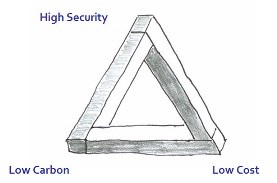Electrification of Transport
Road transport currently accounts for 22% of UK CO2 emissions.
The need to reduce carbon emissions is the principal driving force away from the use of internal combustion engines towards electric drive trains for vehicles. A further driving force is the need to reduce NO2 emissions for health reasons, particularly in cities. Electric engines are small, light and efficient: the challenge is how to provide electric power to a moving vehicle.
For trains access to electric power is through the rails or overhead power lines, but for cars this requires either the need to carry batteries in Battery Electric Vehicles (BEVs) or the use of Fuel Cell Electric Vehicles (FCEVs) which need to be recharged from hydrogen refuelling stations.
Battery Electric Vehicles suffer from the need to transport the weight of their batteries, a restricted range and the time needed to recharge their batteries.
Fuel Cell Electric Vehicles can refuel with hydrogen as quickly as it takes to refuel with petrol, and have a range similar to petrol driven cars. The issue is whether they currently have access to enough local hydrogen refuelling stations.
Electrification of Transport in Norway
In March 2019 59% of cars sold in Norway were electric cars, but in the UK less than 1% of cars sold in March 2019 were electric.
Norway discourages the use of petrol and diesel cars with higher taxes. Electric cars benefit from lower taxes, free use of bus lanes and in Oslo some free parking and free charging of electric vehicles.
The UK could follow the same example if it choose to do so for electric cars. It could also do the same for electric heating.
Demand Response and Distributed Electric Storage
The demand for electricity fluctuates during each 24 hour day. A Battery Electric Vehicle in a Vehicle to Grid (V2G) system can be charged with cheaper electricity if plugged in to a time-of-use sensitive system that charges the vehicle when electricity supply is in surplus (which is often at night).
If a V2G system is connected to a large number of electric vehicles it is effectively connected to a very large electric supply that can be reversed to supply electricity back to the Smart Grid at times of peak demand for electricity (within limits of acceptable discharge for the vehicle batteries): a very large, clean and quiet backup source of electricity: a Virtual Power Plant.
Demand Response and Hydrogen Refuelling Stations
A Smart Grid can signal when it is able to supply electicity at a low price. Hydrogen refuelling stations can take advantage of this cheaper electricity to generate hydrogen using electrolysis and store it for refuelling Fuel Cell Electric Vehicles at anytime.
Shoreham Harbour Heat Network
ICAX is a member of the Smart Hubs SLES project which is pioneering the electrification of heat and transport in Shoreham and establishing a Virtual Power Plant to service electric vehicles in West Sussex.
See Low Carbon Heating See Low Carbon Cooling See Ground Source Energy See Smart Grids

